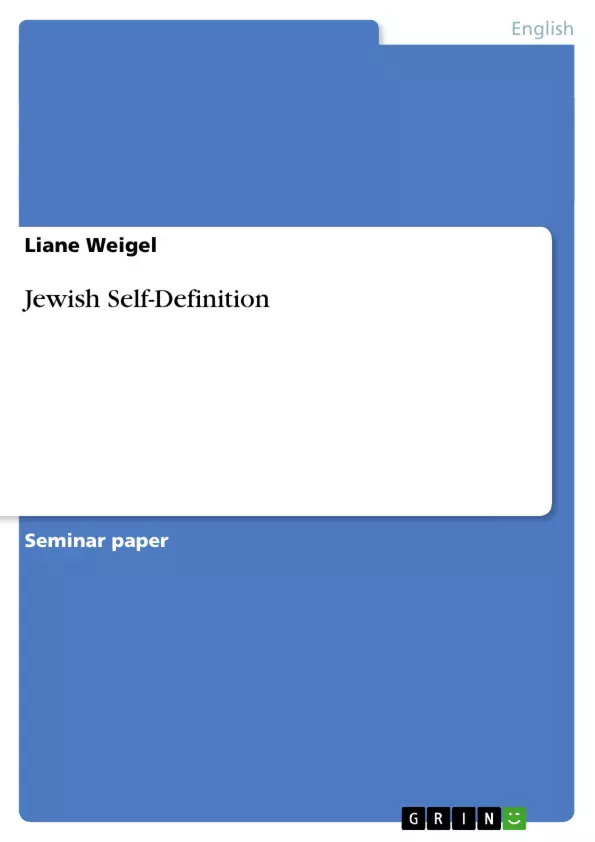Assuming an absolute number of 17.5 million Jewish people in the world and 6.9 million of them living in the USA, a discussion of The Jews in America seems indispensable in the context of American Cultural Studies. Jewish identity in this context has been approached in a greater focus with a wider public, political and religious discussion of the question “Who is a Jew?” 1 . This question, which is certainly connected to a difficult answer, became a very important factor, especially for the Jews in the USA during the 20 th century. Therefore this paper attempts to analyse the changing Jewish self- definition in the USA during the 20 th Century. Although it can or will not answer the complex question, “Who is a Jew?” correctly or in a wider sense completely, it will focus on the development of Jewish continuity and the changes in self-definition in the pluralistic society of the United States during the 20 th century.
A short acknowledgement on Jewish self- definition and - identification in general will be provided, before facts referring to assimilation, Americanisation and authenticity are discussed. The starting point for the changing Jewish self-definition, which is connected to the immigration at the end of the 19 th and the beginning of the 20 th century will be analysed in the second part. The Holocaust, the worst genocide of the century, was, especially for the German Jews, a dramatic experience. Besides traumatic feelings, the perception of the Holocaust and anti-Semitism in general mainly influenced the Jewish self- definition of American Jews, referring to the concept of Zionism and Redemption as strictly linked to a concept of hostility towards Jews. Considering the strong sense of self- identification and self- definition of the Jewish people will therefore lead to the third part where the influence of the perception of the Holocaust and anti- Semitism on Jewish self- definition is analysed. The following part will refer to the appearance of revolutionary ideas as usually revealed in the development of almost every people, society or religion. In the USA the influence of a pluralistic society opens possibilities to reform Jewishness and Judaism and results in the emergence of two types of Jews in the 60s and 70s that still dominate American Jewry.
Inhaltsverzeichnis (Table of Contents)
- 1. Introduction
- 2. Living in a Pluralistic Society: Immigration, Assimilation, Americanisation and Authenticity
- 3. The Jewish Perception of Anti-Semitism in the USA and the Concept of Zionism and Redemption, and the Divisions of Judaism
- 4. Different Jewish Tendencies in the 1960s and 1970s: Polarisation, American- Jews, Jewish- Jews and the Shrinking Middle
- 5. How to Remain Jewish: Jewish Future and Continuity in America
Zielsetzung und Themenschwerpunkte (Objectives and Key Themes)
This paper aims to analyze the evolving Jewish self-definition in the USA during the 20th century. It examines how Jewish identity has been shaped by immigration, assimilation, and Americanization within the context of a pluralistic society. The paper explores the impact of the Holocaust and anti-Semitism on Jewish self-definition, particularly in relation to Zionism and redemption. It further investigates the emergence of different Jewish tendencies in the 1960s and 1970s and considers the future of Jewish continuity in America.
- Jewish self-definition and identity in the context of American cultural studies.
- The influence of immigration, assimilation, and Americanization on Jewish self-definition.
- The impact of the Holocaust and anti-Semitism on Jewish identity, particularly the concept of Zionism and redemption.
- The development of different Jewish tendencies and their implications for the future of American Jewry.
- Jewish continuity and the challenges of maintaining a distinct Jewish identity within a pluralistic society.
Zusammenfassung der Kapitel (Chapter Summaries)
- Chapter 1: Introduction This chapter introduces the topic of Jewish self-definition in America, highlighting the importance of the question "Who is a Jew?" in the context of American cultural studies. It provides an overview of the paper's scope and methodology, focusing on the evolution of Jewish self-definition in the 20th century.
- Chapter 2: Living in a Pluralistic Society: Immigration, Assimilation, Americanisation and Authenticity This chapter discusses the factors influencing Jewish self-definition in a pluralistic society, including immigration, assimilation, and Americanization. It examines the challenges and opportunities faced by Jewish immigrants in the early 20th century and the role of religion in maintaining Jewish identity.
- Chapter 3: The Jewish Perception of Anti-Semitism in the USA and the Concept of Zionism and Redemption, and the Divisions of Judaism This chapter analyzes the impact of anti-Semitism and the Holocaust on Jewish self-definition, particularly the emergence of Zionism and its connection to the concept of redemption. It also explores the divisions within Judaism and their impact on identity formation.
- Chapter 4: Different Jewish Tendencies in the 1960s and 1970s: Polarisation, American- Jews, Jewish- Jews and the Shrinking Middle This chapter examines the development of different Jewish tendencies in the 1960s and 1970s, highlighting the polarization between American-Jews and Jewish-Jews. It discusses the shrinking of the middle ground and its implications for Jewish self-definition.
Schlüsselwörter (Keywords)
Jewish self-definition, American Jewry, immigration, assimilation, Americanization, anti-Semitism, Holocaust, Zionism, redemption, Jewish continuity, pluralistic society, American cultural studies, Jewish identity.
- Quote paper
- Liane Weigel (Author), 2003, Jewish Self-Definition, Munich, GRIN Verlag, https://www.grin.com/document/25633



